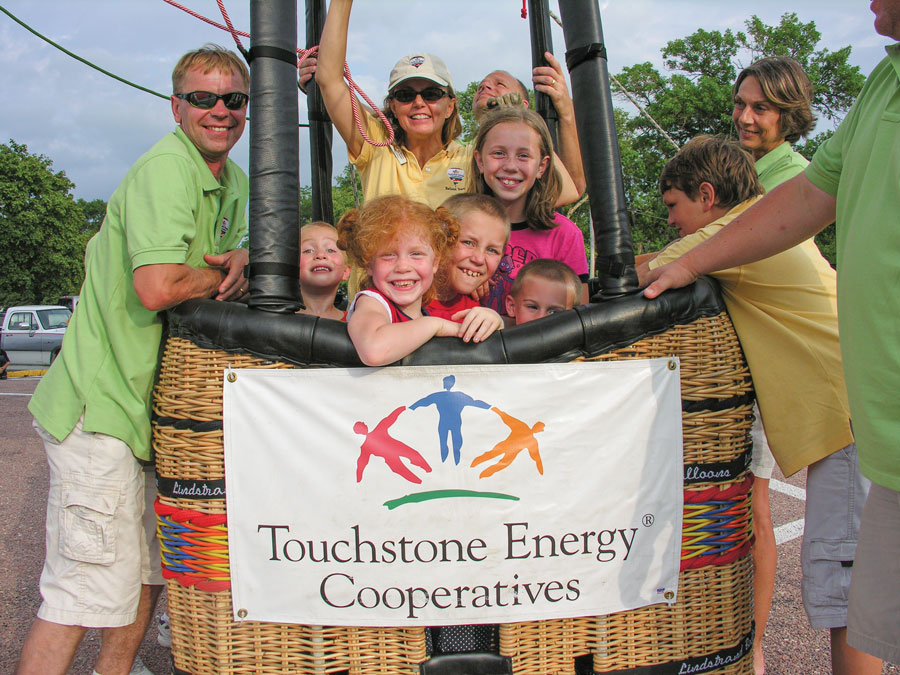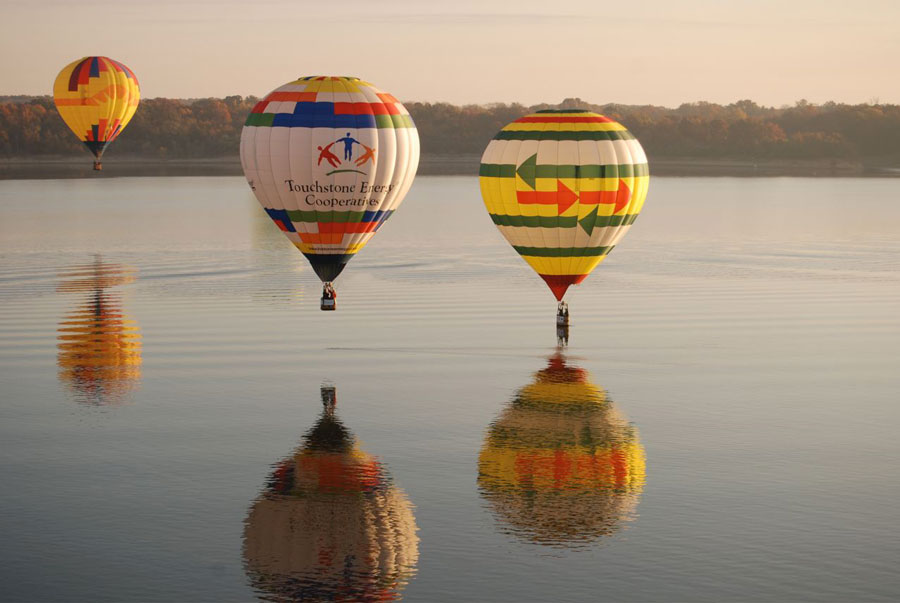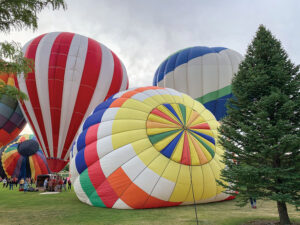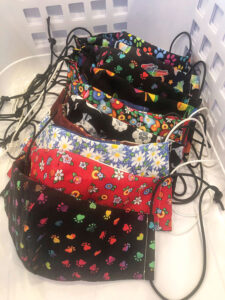“I think we always have a dream to fly,” says Lisa Kempner, sales director of Lindstrand Balloons USA. “That ability to leave the earth … there’s an excitement of not knowing where you’re going because you’re moving with the wind. I think it opens our imagination.”
Kempner, along with company president Phil Thompson, founded the hot air balloon manufacturing business in 1994. Initially, while setting up the business, Lindstrand imported balloons from England, and the company eventually built its first balloon in early ’96. In 2000, Lindstrand built a factory on Jo-Carroll Energy lines in Galena.
Lindstrand Balloons’ 12 employees produce an average of 32 to 38 hot air balloons a year, selling both commercially and to private balloon hobbyists. At the factory, balloons (also known as envelopes) are sewn and designed, baskets are produced, and tanks and burners are tested. The burners are made by another company but manufactured to Lindstrand’s standards.
The balloon manufacturing process begins with the custom design of the balloon envelope with 24 colors from which to choose. On Lindstrand.com, there’s an app clients use to mock up a design. Lindstrand then uses an advanced 3-D program to replicate the work to show how it would look in real life. “Most people don’t realize the artwork on a balloon is not flat,” Kempner says. “We have to manipulate every single angle so it looks straight on a curve, and that gets complicated.”
 From balloons with eye-catching geometric patterns to those with company logos and detailed graphics, Kempner says, “We’re known for our artwork.” Lindstrand Balloons’ CNC (computer numerical control) cutting machine helps the company produce intricate designs. “If we were hand cutting, it would be far more difficult to do,” she adds.
From balloons with eye-catching geometric patterns to those with company logos and detailed graphics, Kempner says, “We’re known for our artwork.” Lindstrand Balloons’ CNC (computer numerical control) cutting machine helps the company produce intricate designs. “If we were hand cutting, it would be far more difficult to do,” she adds.
One design element that sets Lindstrand apart is its use of appendages added to a standard balloon. “We did a cute balloon that has flip flops on the side that were 3-D,” Kempner says. “Just totally adorable and a lot of fun.”
The fabric is specially manufactured for Lindstrand and shipped from the United Kingdom. Kempner explains there are three standard fabrics used in balloons that are durable, long-lasting, fire-resistant and made to withstand high temperatures. The fabrics on the top two parts of the balloon are nylon-based, offering high strength-to-weight ratio, with the fabric on top coated with silicon. The area closest to the burner is made of Nomex, a flame-resistant fabric also used for racing suits. The baskets are trimmed with leather or suede, and the woven part is made with a wicker harvested in Malaysia.
Certified by the Federal Aviation Administration (FAA) to build aircraft, the balloon factory goes through several inspections every three years. Kempner explains the facility is examined from top to bottom to check quality controls, receiving controls, manufacturing practices and inspection. “They use the same rulebook used at Boeing or any other aircraft manufacturer, and they just adapt it for the processes we have,” she says.
Touchstone Energy balloon takes flight
Lindstrand Balloons USA manufactures hot air balloons for the Touchstone Energy Hot Air Balloon program. Touchstone Energy is a network of electric cooperatives across 46 states that provides resources to help member cooperatives better engage and serve consumer-members. To date, Lindstrand has made 10 Touchstone Energy balloons, which are owned by Cooperative Balloon Associates (CBA).
CBA was formed in 1999 by 10 Illinois Touchstone Energy cooperatives looking for a unique way to introduce the brand to members. These co-ops include Coles-Moultrie Electric Cooperative, Mattoon; Corn Belt Energy Corporation, Bloomington; Eastern Illini Electric Cooperative, Paxton; Jo-Carroll Energy, Inc., Elizabeth; McDonough Power Cooperative, Macomb; Norris Electric Cooperative, Newton; Prairie Power, Inc., Springfield; Shelby Electric Cooperative, Shelbyville; Southern Illinois Power Cooperative, Marion; and Rural Electric Convenience Cooperative, Auburn.
“We’re now the second longest operating corporate hot air balloon program in the country,” says Kevin Bernson, CBA board vice chairman and vice president of media and public relations for Shelby Electric. “Touchstone Energy came along the year before as a brand, but this was the first tangible asset that Touchstone had out there for cooperatives to use as a marketing effort.”
Bernson says the Touchstone balloon helps electric cooperatives with brand awareness. “It allows the local cooperatives to tie themselves to the Touchstone brand. … The balloon is one way to make that connection.”
 Cheri White, general manager of CBA, runs the hot air balloon program by scheduling events and pilots. She explains, “I used to do all the events myself, but now we have five balloons and four other pilots scheduled around the country.”
Cheri White, general manager of CBA, runs the hot air balloon program by scheduling events and pilots. She explains, “I used to do all the events myself, but now we have five balloons and four other pilots scheduled around the country.”
Last year, the Touchstone Energy Hot Air Balloon program celebrated its 20th anniversary with a record 45 appearances in 20 states. On average, the balloons fly in 30 to 35 events across the nation annually. With the COVID-19 pandemic this year, they have had many postponements and cancellations. “We went from our very best year in 2019 to our very worst year,” White says.
White has been with the program from the beginning, starting with the 1999 National Balloon Championship in Rantoul, where she won the women’s division and placed 10th overall. She was asked to fly a Touchstone Energy banner on her balloon.
“The Illinois (electric) co-ops involved saw the balloon with the banner and got excited about it,” White says. “They got together to get the seed money to buy the first balloon. The rest is history.”
As a pilot, White has logged more than 2,650 hours flying a balloon. That’s more than 110 days. She was introduced to ballooning at age 13 growing up in Texas. Her father got excited about ballooning and purchased one with a group of people. White and her sister were part of her father’s crew, and she eventually worked for a pilot at age 16 and took her first solo flight at 17. At 19, she bought her own balloon. Recently, she received the Ed Yost Master Pilot Award for 40 years of safe flight.
“The Touchstone balloon has been my life for 20 years. I never thought it would be,” White says. Her career started as an attorney. When she had children, she quit practicing but always did ballooning for fun. “I thought the Touchstone Energy Hot Air Balloon program would be maybe three years … but here I am 20 years later. Fate and luck led me to working with co-ops.”
“My relationship with Touchstone really stems to Cheri White,” says Kempner. “Cheri is such an incredible ambassador for ballooning and for Touchstone … Cheri is the key, and it is her warmth, her personality, her skills … she makes herself well-known in a male-dominated field. It is fantastic that [the Touchstone balloon] is going strong after 20 years, and it’s neat that we are a member of a co-op.”
Have a safe flight
 For a hot air balloon pilot, the weather can be an enemy. “In bad weather, you can’t do anything,” White says. While flying, she explains pilots must also watch for obstacles such as cell towers and power lines. “You’re always being very cautious in flying at a good, safe altitude and making sure you have your equipment checked every year.”
For a hot air balloon pilot, the weather can be an enemy. “In bad weather, you can’t do anything,” White says. While flying, she explains pilots must also watch for obstacles such as cell towers and power lines. “You’re always being very cautious in flying at a good, safe altitude and making sure you have your equipment checked every year.”
According to White, every balloon pilot must have a license with the FAA and have three takeoffs and landings within a 90-day period to stay current. In addition, pilots have a biannual flight review with another pilot to review safety and flight maneuvers. Kempner says pilots often bring their balloons to the Lindstrand facility for balloon inspections and to use its on-site repair station.
White says each Touchstone balloon envelope lasts an average of 350 hours of flight time. “Every time you fly a balloon, you log the time you use it,” she explains. “When you get to around 350 hours, you start noticing the fabric getting a little porous, and that means you’re going through more fuel than you would if the balloon is brand new.”
To date, CBA has retired four Touchstone balloons with another set to retire at the end of the season. However, the original burner and basket purchased in 1999 is still used. “We always fly good, safe equipment,” White says. “We have the best burners you can get and really nice quality fabric.”
Illinois hot air balloon festivals
If you’ve attended one of the many hot air balloon festivals across Illinois, you most likely have seen a Lindstrand balloon. “There are some festivals where we have to laugh,” Kempner says, commenting on the number of their balloons they see. For example, 75 to 80 percent of the balloons at the Macomb Balloon Rally last September were Lindstrand balloons. “For a small balloon event, we were in awe. Almost every balloon was a Lindstrand.”
 Many hot air balloon festivals in 2020 have been canceled due to the COVID-19 pandemic, including Great Galena Balloon Race, Balloons Over Vermilion in Danville, Eyes to the Skies Festival in Lisle, The Great Balloon Race in Galesburg and Quad Cities Balloon Festival. Centralia Balloon Fest will host a “balloons-only” event due to social distancing requirements Aug. 21-23.
Many hot air balloon festivals in 2020 have been canceled due to the COVID-19 pandemic, including Great Galena Balloon Race, Balloons Over Vermilion in Danville, Eyes to the Skies Festival in Lisle, The Great Balloon Race in Galesburg and Quad Cities Balloon Festival. Centralia Balloon Fest will host a “balloons-only” event due to social distancing requirements Aug. 21-23.
The Touchstone Energy Balloonfest at Lake Shelbyville is still scheduled for October 10-11. Bernson helps coordinate the event, which coincides with Shelbyville’s annual Scarecrow Daze. “When the balloon event came to Shelbyville, I didn’t think about the economic impact that even a small balloon event would have,” he says. “Local businesses often say it’s their best weekend.”
Bernson says the final decision has not been made for the event because it is still several months away. Check Facebook.com/balloonslakeshelbyville for updates.
“If you’ve not had the opportunity to go to a hot air balloon event, or if you hear the Touchstone balloon will be in your area, I highly recommend going because it is a great opportunity and fun for the whole family,” he says.
Sky’s the limit
 Kempner recommends everyone take a ride in a hot air balloon because the experience is so personal. “The one thing I’ll say about the world when you fly, everything looks clean. You get up about 500 feet in the air and look around. You have no idea how perfect the rows are that the farmers plant or how incredible it looks. It doesn’t seem real. Everything looks so planned and so perfect.”
Kempner recommends everyone take a ride in a hot air balloon because the experience is so personal. “The one thing I’ll say about the world when you fly, everything looks clean. You get up about 500 feet in the air and look around. You have no idea how perfect the rows are that the farmers plant or how incredible it looks. It doesn’t seem real. Everything looks so planned and so perfect.”
“It’s not jerky at all,” says White, describing what it’s like flying in a balloon. “People think it will be like a carnival ride, but they don’t even know we have left the ground. It is that smooth. When you’re flying, you’re floating with the wind. … You can talk to people on the ground, you see deer and all kinds of animals. You go across a cornfield, just flying right above the tassels. Flying above trees and going up to look at your whole city. It is beautiful and peaceful.”
From balloons to face masks
When the COVID-19 pandemic reached Illinois, the production of Lindstrand balloons came to a halt as Illinois’ stay-at-home order came into effect. With the demand for face masks skyrocketing, Lindstrand Balloons already had the equipment and began producing face masks.
 When Lisa Kempner saw a request for masks from UnityPoint Health, which published a mask pattern, she purchased fabric and allowed a few employees to come in and sew masks. Lindstrand’s facility has 8,000 square feet, which allowed for social distancing, and everything was sanitized.
When Lisa Kempner saw a request for masks from UnityPoint Health, which published a mask pattern, she purchased fabric and allowed a few employees to come in and sew masks. Lindstrand’s facility has 8,000 square feet, which allowed for social distancing, and everything was sanitized.
With that, they used a computer patterning program that makes patterns for a cutting machine, and they got to work sewing masks. “We could do social distance really well and keep the place clean, and we take temperatures now when people come in,” Kempner says.
Initially, Kempner couldn’t find any elastic, so many of the masks were made with cord from the balloons instead. They even tried using hair ties. “We got really creative with bits and pieces,” she says.
Lindstrand produced hundreds of face masks instead of balloons for seven weeks. “We didn’t charge anything. We just gave them away as people needed them,” Kempner says. They also donated precut masks to other groups to sew.
“We are firm believers that we are responsible for our neighbors,” Kempner says. “We have to stay safe so they can be safe.”








